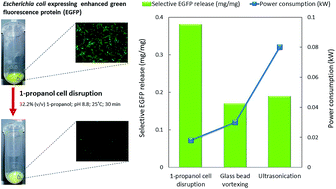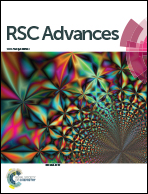A versatile and economical method for the release of recombinant proteins from Escherichia coli by 1-propanol cell disruption†
Abstract
Cell disruption is a crucial step in the downstream processing of intracellular proteins from microbial cells. In general, mechanical methods of cell disruption are energy intensive and non-selective in protein release. Thus, chemical cell disruption offering a high selectivity in protein release and a low operating cost is highly sought after. In this study, a versatile cell disruption method based on alcohol permeabilization was developed and applied to a model system, namely Escherichia coli expressing an enhanced green fluorescent protein (EGFP). The disruption process was optimized using a response surface methodology. The optimum condition of cell disruption was attained at 32.2% (v/v) 1-propanol (1-PrOH), pH 8.8 and 25 °C. The active EGFP release obtained from the optimized 1-PrOH cell disruption (1.27 mg mL−1) was comparable to that from ultrasonication treatment (1.35 mg mL−1). In addition, the selective EGFP release achieved by 1-PrOH cell disruption (0.38 mg mg−1) was 2-fold higher than that by ultrasonication treatment (0.19 mg mg−1). The power consumption of 1-PrOH cell disruption (0.018 kW) was the lowest in comparison to that of ultrasonication treatment (0.08 kW) and glass bead vortexing (0.03 kW). Moreover, a high relative EGFP release can be achieved by 1-PrOH cell disruption conducted over a wide range of working parameters [3–62% (v/v) of 1-PrOH, pH 8–11 and 15–30 °C]. The versatility of this 1-PrOH cell disruption method is useful for the release of labile proteins through a fine adjustment of the working parameters based on the target protein's alcohol tolerance limit. This versatile and economically viable method holds great promise for lab- or large-scale microbial cell disruption due to the wide availability, inexpensiveness and recyclability of alcohol.



 Please wait while we load your content...
Please wait while we load your content...